This article is part of our EndangerBus project — watch for the buses in San Francisco January 2011!
If you’re lucky some spring day on San Bruno Mountain or in the Marin Headlands, you may catch the glint of a male mission blue butterfly’s iridescent wings. And if you and the butterflies are really lucky, you might see them at Twin Peaks in San Francisco. These few remaining pockets of the mission blue’s once-abundant coastal scrub and grassland habitat support its caterpillar’s only food plants (three lupine species) and are home to all life stages of this petite endangered insect.
A mission blue spends most of its year-long life in a state of suspended development called diapause. Mission blue eggs, laid only on lupines, hatch in March through June each year. For a few weeks, a new caterpillar eats lupine leaves and grows by molting before it drops into leaf litter beneath the plant and enters several months of diapause.
- Purple lupines, habitat for the Mission Blue butterfly is seen here on the Southeast ridge of San Bruno Mountain. Public domain image by Patrick Kobernus.
As the lupine puts out new leaves the following spring, the caterpillar resumes feeding and growing. Then it develops into a pupa and in about a week undergoes a complete change in body form, emerging as an adult butterfly. During its brief adult life, the butterfly can no longer eat solid food but instead sips nectar to fuel its primary activities: mating and egg-laying. Adult mission blues are weak flyers, seldom leaving their lupine patches and rarely moving when winds rise above about 15 mph or temperatures fall below 55 degrees Fahrenheit.
In addition to the vagaries of weather, mission blues are vulnerable to predators that include birds, rodents, and other insects. The most unusual are parasitoid wasps. Hatching from eggs laid inside the caterpillar’s body, the tiny wasp larvae kill the caterpillar as they eat their way out. But an interesting mutualistic relationship with native ants can protect the caterpillar: The ants tap on the caterpillar’s back to collect the sweet, protein-rich honeydew it excretes and in the process shield it from the wasps.
Protecting the mission blue from more pervasive threats is more difficult. Urban expansion has drastically reduced coastal scrub and grassland habitat in the butterfly’s natural range, and within the remaining habitat, introduced invasive plants like broom and pampas grass are displacing the caterpillar’s host lupines. Further habitat damage comes from increased recreational use and trampling under human and canine feet.
Development pressure is especially great around San Bruno Mountain, where most mission blue butterfly habitat is on private land. After the mission blue was federally listed as endangered in 1976, landowners agreed to designate some of their land for parks and restore degraded habitat within those parks in trade for permission to build elsewhere on the mountain. Critics say it was a better deal for landowners than butterflies. Local residents formed San Bruno Mountain Watch, an active critic of such trade-offs that works to preserve and restore habitat on the mountain.

- A female mission blue butterfly rests on a yarrow plant located on the southeast ridge of San Bruno Mountain. Public domain image by Patrick Kobernus.
Another population of mission blues has barely persisted at San Francisco’s Twin Peaks, where the species was first described in 1937 (the butterfly’s name refers to San Francisco’s Mission District, in which Twin Peaks was once included). After finding only two adults and two caterpillars at Twin Peaks between 2001 and 2007, scientists and volunteers working with city and federal agencies began planting the butterfly’s host lupines. In the spring of 2009, they relocated 22 adult mission blue females from San Bruno Mountain to Twin Peaks. Those butterflies laid eggs, and volunteers were gratified to find 30 mission blue butterflies at Twin Peaks the following spring.
The small populations of mission blues in the Marin Headlands area of the Golden Gate National Recreation Area are more stable, and protection efforts there focus on replacing invasive plants with native coastal grassland species including the butterfly’s host lupines.
That a tiny, cold- and wind-intolerant butterfly once thrived in foggy coastal Bay Area counties seems surprising. The mission blue’s need for habitat in areas under development pressure has set its continued survival at odds with urban growth, but dedicated efforts by committed habitat stewards now offer hope for the species to recover.
For more about the mission blue butterfly:
Butterflies and Bulldozers on an Island of Time (Bay Nature feature)
Mission blue page of the Essig Museum of Entomolog
Mission blue page of the Golden Gate National Parks Endangered Species Big Year
Butterflies of San Francisco field guide from Nature in the City

.jpg)


-300x205.jpg)
-300x148.jpg)
-300x207.jpg)